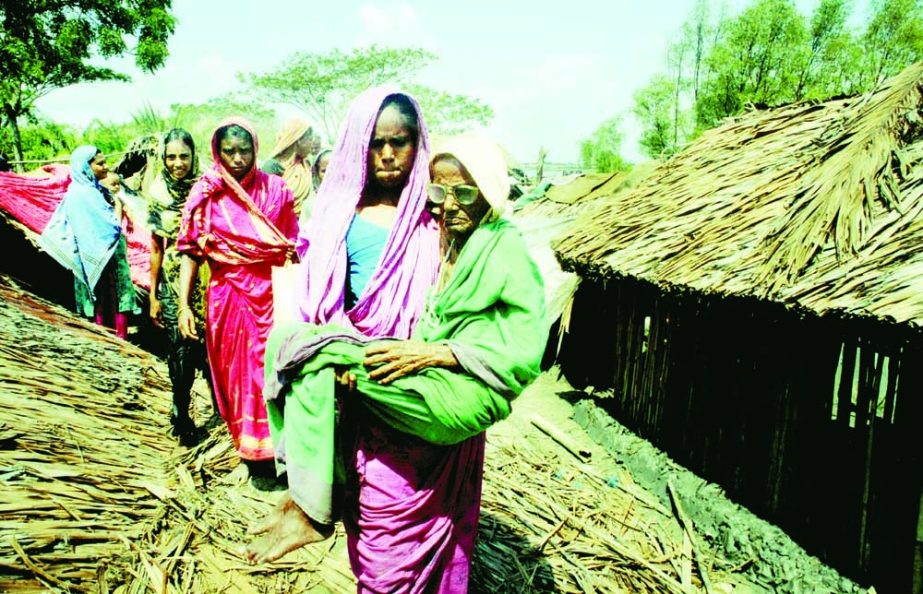
Anisur Rahman Khan :
Two thousand people are being internally displaced every day due to the adverse climate change in Bangladesh.
According to International Displacement Monitoring Centre (iDMC), internal displacement in Bangladesh is inextricably linked to the effects of climate change, which exposes communities to a wide array of shocks and stresses.
Between 2008 and 2014, it is estimated that 4.7 million people were displaced due to disasters in Bangladesh and the sufferings are forecasted to increase in frequency and intensity. Over the last decade, an average of 700,000 Bangladeshis were displaced each year by rapid-onset natural disasters as was the case with Cyclones Aila (2009), Viyaru (2013), Koman (2015), Roanu (2016), Mora (2017), Bulbul (2019) and Fani (2019).
With an estimated 4.1 million victims of climate change in 2019, according to data available since 2008, Bangladesh booked a berth in the top countries globally when it comes to the question of disaster-related internal displacements. The year of 2020 continued along this path with 2.5 million new displacements caused by Cyclone Amphan, experts said.
Displacement and migration in Bangladesh are a complex picture comprising rapid-onset hazards or shocks, ranging from floods, cyclones and storm surges, to chronic stresses including drought, salinity intrusion, sea level rise, and coastal and riverbank erosion, to man-made shocks such as fire, pollution, deforestation, water logging, conflict and public health challenges including the COVID-19 pandemic.
Climate change continues to exacerbate these shocks and stresses, with coastal regions particularly at-risk to cyclones, storms and rising sea-levels, while mainland regions are more impacted by riverbank erosion and flooding.
Around 70 per cent slum dwellers in Dhaka are climate refugees, they say. Bangladesh has had to face strong cyclones like Sidr, Aila, Komen, and Roanu in recent years. At least two to three strong cyclones are likely to strike this year in the Bay of Bengal, sources said.
According to the Coast Trust, 35 strong cyclones have developed in the Bay of Bengal in recent years. Of these, 16 have hit Bangladesh’s coastal areas. At least 5,000 people have been killed due to these cyclones, which accounts for 53 per cent of the people in the world killed due to cyclones, the experts said.
There will be a negative impact on food security due to the volatile temperature, the experts said, adding that the production of potatoes will decline by 60 per cent. Besides, salinity of agricultural land will increase which would hamper production. The Sundarbans has shrunk by 8.3 per cent between 2000 and 2010. As a result, the risk of depression and cyclones has increased in these areas.
According to a study report of the Coast Trust, 44 flood protection embankments out of 123 are at risk and will sink due to the water surge caused by cyclones. Around 75 per cent people in Satkhira, 32 per cent in Khulna, 72 per cent in Barguna, and 66 per cent in Bagerhat are now suffering from a paucity of pure drinking water.
Experts suggested both short- and long-term initiatives to protect coastal people from cyclones and salinity. They also suggested that the embankments be repaired on an urgent basis to prevent tidal surges.
Sustainable river-dredging and the construction of embankments through scientific methods are needed, they said, adding that rivers and canals should be freed from encroachments. “It is not true that 17 per cent of Bangladesh’s area will go under water. There are embankments more than 12 to 15 feet high in coastal areas. The coastal areas will be flooded only after a tidal surge,” climate expert Ainun Nishat told The New Nation.
He said there are also economic migrant in Bangladesh due to river erosion or cyclones.
“There are changes in coastal areas. People are migrating to various towns not only for climate change. The poor people are coming to near by towns or capital city Dhaka to earn money,” Nishat said.
According to Bangladesh Meteorological Department (BMD, normally, March, April, May, October, and November are considered the months of cyclones. Besides, the country has to face nor’westers in March or April.

